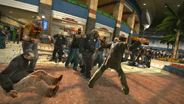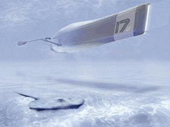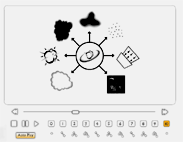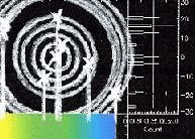
MIT’s Knight Science Journalism program has just published an interview with me in which I discuss Collision Detection — including why I started it. As is probably obvious, I started blogging partly as a way to think out loud, and to write about things that are too weird, quirky, or timely to fit into long-form magazine journalism.
But in the interview, I also discuss the subtler reason I started the blog: As a Google hack. I was tired of my doppleganger Clive Thompson — the billionaire CEO of Rentokil in the UK (or, as Martha Henry, the acting director of the MIT program who interviewed me, refers to him, “the toilet guy”). The interview’s online here, and this is an excerpt:
Me: I wanted to establish myself as easy to find on Google … I started the blog because when you’re a freelancer, you don’t belong to an organization. It’s very hard to find you. So I needed to establish an unshakeable presence.
Google is the determiner of reality on-line and I know the way Google works. Blogs attract a lot of links; other bloggers link to you. You very quickly build up a huge amount of what’s called “Google Juice.” And sure enough, three months after I started the blog, with barely a couple dozen links pointing to me, I was already on the first page. Within a year, I was number one. Basically, I’m undislodgeable at this point in time.
MH: So you’ve obliterated the toilet guy.
CT: I’ve obliterated every other Clive Thompson.
You will respect mah authoritay.

Wired News just published my latest video-game column — and this one is about the weirdly philosophical dimensions of “save mechanics”: The moment in a game where you save your progress so you can return to it in case you later screw something up. The piece is online here for free, and copy is archived permanently below!
Saved by the Bell
by Clive ThompsonThe worst part wasn’t the dying.
After all, I knew I was doomed as soon as the zombies staggered into the men’s clothing store. I’d used up my weapons, depleted my life-giving orange juice, and was cowering behind a display of men’s shoes with a health meter drained to zero. I launched one futile banzai attack on the mob, but you know how it is with zombies — they collapse all over you like a bunch of mooing linebackers, and pretty soon you’re lunch. Dead again.
But, like I said, the problem wasn’t the dying. It was being reborn — and having to go back to square one.

Here’s a cool experiment: A cardiac electrophysiologist is investigating whether you can calm a recovering heart-surgery patient by playing live harp music. A lovely story in today’s New York Times reports on a four-week study currently underway, in which harpist Alix Weisz wanders through a cardiac recovery unit in Chester, NJ, playing music — while doctors check to see if it helps regularize the patients’ heartbeats or other vital signs.
Apparently the patients dig it quite a lot; as one notes:
“When I was coming out of it, I was filled with tubes — a throat tube, an oxygen tube — and it was very hard to breathe,” Mr. Moran said. “You feel you’re going to gag. The music calmed my body and allowed me to stop thinking about what was going on. It allowed me to feel more relaxed and rested.”
Of course, doctors have long anecdotally supsected that music can help calm patients down. But as I discovered when I started Googling this a bit, there’s a ton of interesting research underway that is tentatively finding that music can help calm down even unconcious patients. Though the Times story doesn’t mention him directly, I think the Chester study is being done by Abraham Kocheril, a cardiac researcher who last year played harp music for patients under anesthesia and found that it appeared to regularize their heartbeats — making an unhealthy heart function more like a healthy one and, presumably, improving the patients’ chances on the operating table. (There’s a good CNN story about his work here.)
Another researcher, Harvard’s Ary Goldberg, argued that there are fractal features common to both music and the human heartbeat, and that music can help tune the heart by rebooting with healthy fractal noise — allowing it to respond with more dynamism to a bigger array of physical challenges.
(Funny side story: When I did a Google search for “‘Ary Goldberg’ music”, I noticed that the seventh link was to … Collision Detection. Wha? I hadn’t recalled ever posting about him. But when I clicked on the link I discovered that Dusty Bear, a regular commenter on this site, had namechecked Goldberger back in March when I wrote about an album of music made from the stock market.
Heh. Talk about fractal patterns, eh?)

If you’ve seen the serpentastic film Snakes on Plane, you’re familiar with the movie’s superb use of “Snake-O-Vision” — the many moments when the camera shows a snake’s-eye view of an impending attack. According to the movie, the snakes “see” their prey in green night-vision, with a round pinhole-camera-like center that’s in focus, and a periphery that’s blurry. Like everyone else in the movie theater, I laughed my head off when I saw it.
But then I wondered: How scientifically accurate is Snake-O-Vision?
As it turns out, the question of Snake-O-Vision has long puzzled scientists, particularly in two types of deadly serpents — pit vipers and boid snakes. These snakes can strike prey with accuracy even when they’re blindfolded, which suggests they’re using a “pit organ” on each side of their head that senses infrared radiation. The problem is that these pit organs are one millimeter in size and not very deep — which means they could produce only extremely blurry images. So how do the snakes do it?
A trio of German scientists now theorize that the snakes use firmware in their brains to error-correct the lousy imagery by harnessing the infrared noise produced by a moving prey. They built a neural-net model in a computer that mimics this, and fed it the actual data produced by a pit organ’s 2000-odd receptors. Presto: It refined the blurry images into startlingly precise results. Check out the example above: There’s the actual bunny, the blurry image from the pit organ (top right), and the result generated by their neural net (bottom right).
Okay, but how do we know this theoretical model matches what’s actually going on inside the snakes’ brains? We don’t — but the theory makes one superb prediction. It’s this: If the pit organ generates even tiny errors, it would ruin the image. To minimize the errors in the scientist’s model, the pit membrane would have to be no more than 15 microns thick — one fifth the thickness of a sheet of paper. And that is precisely the thickness found in a real snake.
As one of the scientists, Leo van Hemmen, told The New Scientist:
“We’ve found a simple way that something seemingly impossible could work in the snake,” he says. “If we could work it out, we’re sure that nature could too.”
A paper on the experiment was published this month in Physical Review Letters, but it is, alas, behind a paywall.

In the wake of the just-plain-bonkers Forbes article of this week — which argued that men shouldn’t marry “career women” because they won’t make subservient enough wives — I was intrigued to read about some claims in a new study: That fatherhood can affect the structure of your brain, making it more goal-oriented.
At least, if you’re a marmoset. A handful of neurologists recently decided to examine the brains of father marmosets. Why? Because male marmosets are exceptionally devoted to their children — they carry ‘em around more than half the time, passing them to the mothers only when the kids need feeding. The scientists theorized that this unusual behavior might cause, or be the result of, slightly tweaked brain structure. Sure enough, when they examined father marmosets, they found that their prefrontal cortexes had suggestions of higher neural activity — more dendtritic spikes. The cortexes also had more receptors for vasopressin, a molecule that influences social behaviour and pair-bonding.
Craig Kinsley of the University of Richmond, Virginia, who did the work with rat mothers, speculates that Dr Gould’s new findings may reflect human behaviour quite closely. “There is a lot of interest in the idea that having children forces responsibility on males in many respects. If you consider that the prefrontal cortex plays a major role in planning, judgment and the anticipation of the consequences of behaviour, you could make a clear argument that the changes in that part of the brain would be involved with judicious attention toward offspring.”
Given that my infant son is now 8 months old, I wonder if my brain is loaded down with tons of juicy vasopressin? I actually don’t have much to add to this, other than the admission that I think I posted this study primarily so I could run a picture of fuzzy little marmosets.
(Thanks to SciTech Daily for this one!)

You’ve probably heard of the “acrostic” — a poem that is written such that the first letter in each line spells out a word, going downwards. But did you know that John Cage developed his own poetic form that riffs off this? In his version, the new word runs up the spine of the poem: It’s a letter in the center of each line that spells out a word. Cage called it the “mesostic”, using the greek word “mesos” for “middle.”
From a page devoted to mesostics, this is one of Cage’s earliest attempts:
| the b | Eautiful |
| o | Xen are |
| ro | Aming |
| a | Mong us |
| op | Portunity is |
| be | Laboring |
| th | Em |
Ah, but now the fun begins. Over at his blog euph0r1a, Matthew McCabe has created the “Mesostomatic” — a little web tool for automatically generating mesostics! Pump in the words you want the mesostic to spell, a URL for the engine to scrape text from, and presto: It generates one. I had it spell out Collision Detection — bien sur — and use text from Arts and Letters Daily. The result is after the jump!

So, I’m sitting in a theater Saturday night waiting to see the midnight showing of Snakes on a Plane, and the advertising trailers are showing. A CGI-animation ad opens up with a car racing through a decrepit downtown, swerving into oncoming traffic, nearly missing pedestrians, then screeching to a halt in front of a corner store. A guy emerges, dressed in a black leather jacket and trucker shades.
And I’m thinking: What is this? An ad for some sort of video game? It looks like some vague riff off Grand Theft Auto …
… which, as it turns out, it precisely is. I was watching the by-now-famous Coca-Cola parody ad, in which a GTA-style hero drinks a Coke and is so ennobled by its good vibes that he goes on a feel-good rampage that forms a direct moral inverse of the Grand Theft world: He foils a purse-snatching, returns a lost bag of bank money, gives his jacket to a homeless guy and stuffs him into a car full of hot chicks. (That latter act is particularly hilarious — a dead-on reversal of your signature move in GTA, which is ripping hapless folks out of their cars as you jack them.)
As you’d imagine, the gaming blogosphere has widely praised it as funny and witty. But I don’t think any of them have truly understood what’s so culturally epochal about that ad: It does not directly reference Grand Theft Auto. Nothing in the game mentions it by name, or even alludes to the name. No, the advertisers merely presume their audience is so familiar with GTA — including the way it looks, feels, and plays — that they can simply shoot forward to the complex visual joke.
I have to admit, I’m surprised. Probably because I frequently write about games for mainstream publications, I continually have to grapple with the fact that a lot of people — and I mean a lot, particularly anyone over the age of 30 — have no clue how GTA plays or feels, which is precisely why they believe it’s a tool precision-engineered for turning kids into homicidal urban vampires. But maybe I’m wrong. Coca Cola — hardly the most marginal, renegade corporation — has clearly polled the hell out of the youth market and decided that everybody and their dog a) knows about GTA and b) can recognize something that riffs off of its iconoclastic style.
Indeed, the Coca Cola advertising team may even understand something much more subtle: c) that the average youth realizes that GTA is a self-parodying game — i.e. that its purportedly psychotically amoral violent gameplay includes some incredibly self-mocking elements, as well as some acerbic satires of gormless politicians, rapacious capitalists, and kill-‘em-all right-wing talk-show hosts that are heard on GTA’s radio stations — and that the Coke ad thus can exist as yet merely another layer of skin to be peeled off the endlessly ironizing onion of pop culture. The ad parodies violence in a game that parodies itself.
Heh. Joe Lieberman, Hillary Clinton — give up. You’ve lost. Move on to fresh fodder in the culture wars. Grand Theft Auto has become wholesome.

I love this: Swedish designer Milko Ozlu has created the specs for a human-powered submarine. It’s kind of like a sealed, waterproof scull: Two people sit and row oars that jut out the sides of the craft, and which turn sideways with each forward sweep so they don’t inadvertantly propel the craft backwards.
Back in the early 17th century, the Dutch inventor Cornelius Drebbel designed a similarly oar-powered underwater craft, which never caught on. Apparently Ozlu hadn’t heard of the Drebbel sub when he began work on his creation. Ozlu was mostly just interested in repurposing the motion of sculling — which is highly efficient and conservative of human energy — in a new direction. As he notes in this interview:
“I envision the target group for Uscull as people who enjoy water activities, below or above surface,” says Milko. “As the vehicle has clear parallels to scuba diving and rowing, users with either background could make a smooth transition into the Uscull. The underwater aspect adds a third dimension to rowing,” adds Milko.
Heh. It also adds a new dimension to drowning, probably. Or maybe not: These things are designed to submerge only a few feet, so they might be pretty safe. More pix are here!
(Thanks to Erik Weissengruber for this one!)

Peel open the latest copy of the Economist and you’ll find an ad placed by a company that claims to have discovered the secret to free energy. I’m not joking: The company, Steorn, claims that it has “developed a technology that produces free, clean and constant energy”, and that their technology “has been independently validated by engineers and scientists — always behind closed doors, always off the record, always proven to work.” As they note on their web site, this “appears to violate the ‘Principle of the Conservation of Energy’, considered by many to be the most fundamental principle in our current understanding of the universe” — i.e. the concept that energy can neither be created nor destroyed.
Whatever. This is clearly junk science, of course. But as Kieran Healy at Crooked Timber notes, Steorn hews perfectly to the “seven warning signs of bogus science” laid out in the Chronicle of Higher Education a few years ago. To wit:
1. The discoverer pitches the claim directly to the media.
2. The discoverer says that a powerful establishment is trying to suppress his or her work.
3. The scientific effect involved is always at the very limit of detection.
4. Evidence for a discovery is anecdotal.
5. The discoverer says a belief is credible because it has endured for centuries.
6. The discoverer has worked in isolation.
7. The discoverer must propose new laws of nature to explain an observation.
Sounds about right — and come to think of it, intelligent design fits all seven criteria perfectly, too.
(Thanks to Morgan for this one!)

As most astronophiles now know, Pluto’s still a planet. While reading a recent story on the Pluto debate in The New Yorker (sorry, no link because the story’s not online), I happened upon a description of the rules that govern the naming of new planets — and their craters, rings, and other features.
As it turns out, they’re incredibly surreal. Say you’re the lucky astronomer who’s just discovered a new chasm on Venus. What are you permitted to call it? According to the International Astronomical Union, the only permitted names are “Goddesses of hunt” or “moon goddesses.” Maybe you’ve found a bright spot on Ganymede? You can name it after any “Gods and characters of frost, snow, cold, and sleet from myths and folktales of cultures of the Far North.”
The full list of rules is online here. Some of my favorites include:
Small craters of Mars: “Villages of the world with a population of less than 100,000.”
Craters on the moon: “Deceased American astronauts are commemorated by craters in and around the crater Apollo. Appropriate locations will be provided in the future for other space-faring nations should they also suffer fatalities.”
Large ringed features on Callisto: “Places (other than rivers, valleys and ravines) from myths and folktales of cultures of the Far North.”
Small satellites of Uranus: “Heroines from Shakespeare and Pope.”
Small satellites of Neptune: “Gods and goddesses associated with Neptune/Poseidon mythology or generic mythological aquatic beings.”
As I’ve said before, I truly love the culture of astronomers. It’s a nuanced blend of rigorous scientific discipline and baked-out-of-their-minds stoner logic. Half the guys, I swear, if they weren’t mapping the stars with billion-dollar telescopes, they’d be out in California painting unicorns on the sides of vans.

Okay, so, we all know that many of today’s theoretical physicists of “string theory” claim that reality exists in ten dimensions. But who the heck actually claims to be able to visualize this? Half the time it sounds about as ridiculous as the Crisis on Infinite Earths.
So hie the to the web site for Rob Bryanton’s book Imagining the Tenth Dimension, where he has crafted a surprisingly good Flash-based primer on how to wrap your noodle around a ten-dimensional universe. Or would that be universes? Universii? Anyway, check out the animation; it’s good! You probably won’t even need to read the book afterwards —though technically speaking, a differently-dimensioned version of yourself already has.
(Thanks to Fishy for this one!)

This is gorgeous: Mark Fischer, an audio engineer, has been using wavelets to transform audio files of whale music into these mandala patterns. Wavelets tend to emphasize regular patterns in signals, and when presented with a cylindrical co-ordinate system, they result in these lovely circles. As a story in yesterday’s New York Times Science section notes:
Peter Tyack agrees that the technique has potential not only as art, but as a scientific research tool. A senior scientist at Woods Hole Oceanographic Institution, Dr. Tyack studies the way humpback whales communicate, trying to show that the repetitions in whale songs follow grammatical rules similar to those of human language.
“Looking at those figures, it looked like you could see a lot of repeated units,” Dr. Tyack said of the images. “It looks like he’s visualizing some of the points that we made in the paper about humpback song.”
Reminds me of those dudes down on Wall Street who hired algorithm artists to parse stock-market data and produce similar mandalas. They claimed that by staring at them all day long they could intuit otherwise-unnoticeable patterns, predict stock trends, and make bazillions of dollars.

There hasn’t been nearly enough squid news around here for the longest time. I intend to end the drought, beginning today, with this: The best squid-related TV advertisement I’ve ever seen, anywhere, hands down — as well as a cautionary tale of precisely the sort of terrible celaphopod uprising that mankind ignores at its eternal peril.
Click here to watch it! I posted an early frame from the ad because I didn’t want to give away the surprise.
(Thanks to Paul Gemperle for this one!)

Last month I wrote a profile of Will Shortz, the crossword-puzzle maven, and used it as an opportunity to muse on the surging popularity of Sudoku — a puzzle that is the anti-crossword, since you can be both illiterate and innumerate and still have fun solving one. As I pointed out, Sudoku’s blitzkrieg assault on American puzzledom has enormously annoyed cruciverbalists — crossword-puzzle constructors — since Sudoku can be churned out instantly by a computer program, and require no human artistry.
Now Matt Gaffney, a cruciverbalist himself, has written a terrific essay for the American Prospect in which he discusses a new puzzle book he’s recently authored, in which the puzzles are a crossword-Sudoku hybrid. The puzzle format has apparently been around for a long time, and normally is called “Alphacodes” or “Coded Crosswords”. But Gaffney’s publisher is so enthralled by Sudoku that he insisted Gaffney figure out a Japanese name for it. As Gaffney writes:
It’s a language-specific puzzle that’s never been seen in Japan, I replied. It doesn’t have a Japanese name.
“Then come up with one,” he shot back. “Marketing wants a Japanese name. Can you have it to me by Tuesday?”
So I called my girlfriend, who’s the director of a school that teaches English to visiting foreign students.
“Put a Japanese student on the phone,” I told her. [snip]
She found a guy named Yuki, who’d been in the States six years and spoke lovely English.
“Codebreaking?” he replied. “In Japanese, that’s kaidoku.”
How perfect was that? It sounds so much like Sudoku that people just might start associating it with its better-known cousin. Marketing loved it.
Heh.
(Thanks to Jeff MacIntyre for this one!)

This Sunday, Jonathon Keats unveiled the world’s first exhibit of extraterrestrial art — art generated by intelligent signals he claims were received by the Arecibo Observatory in Puerto Rico. That’s a sample above. A press release from the Magnes gallery, where the art is one display, calls it “most significant addition to the artistic canon since the Mona Lisa, or even the Venus of Willendorf.” Ahem. As the artist himself notes:
“This is the ultimate outsider art,” notes Keats. “Historically our culture has ignored extraterrestrial artistic expression. Exhibited at the Magnes, the art becomes accessible to everyone … It’s a familiar story. Researchers expect intelligent life elsewhere in the universe to behave just like them. Since scientists are mathematical, they expect extraterrestrials to broadcast the digits of pi or the Pythagorean theorem.”
Keats began seriously to question the wisdom of these assumptions while conducting independent research early last year. “If I were an extraterrestrial trying to communicate with beings elsewhere in the universe, I certainly wouldn’t transmit something they already knew,” he argues. “I’d try to express something about myself, as profound as possible, in the most universal language I could imagine: I’d send art.”
At first I thought, man, this Keats guy is off his rocker. But then I did a bit of research and realized he’s off his rocker in a calculated fashion. Keats is famous for prank-style art projects, including one in which he sat in a chair and thought for 24 hours, then sold his thoughts to patrons as art. In 2002 he held a petition drive for the city of Berkeley, California to pass a version of A=A, a logical law, as statutory law (“every entity shall be identical to itself,” as his proposed law read).
So once I realized he was pulling our legs, I also realized he’s made a sort of interesting point. Why do we expect that an extraterrestrial race would broadcast mathematical concepts — such as a sequence of prime numbers — as a transmission? Obviously we suppose that math is universal, and thus transcends whatever weird tentacle-based language the aliens speak. But the fact is that we humans broadcast our first official message to aliens — a series of recordings sent aboard the Voyager interstellar mission — we included, yep, art: The first movement of the Brandenburg Concerto and Chuck Berry’s “Johnny B. Goode”, among other things.
I'm Clive Thompson, the author of Smarter Than You Think: How Technology is Changing Our Minds for the Better (Penguin Press). You can order the book now at Amazon, Barnes and Noble, Powells, Indiebound, or through your local bookstore! I'm also a contributing writer for the New York Times Magazine and a columnist for Wired magazine. Email is here or ping me via the antiquated form of AOL IM (pomeranian99).

ECHO
Erik Weissengruber
Vespaboy
Terri Senft
Tom Igoe
El Rey Del Art
Morgan Noel
Maura Johnston
Cori Eckert
Heather Gold
Andrew Hearst
Chris Allbritton
Bret Dawson
Michele Tepper
Sharyn November
Gail Jaitin
Barnaby Marshall
Frankly, I'd Rather Not
The Shifted Librarian
Ryan Bigge
Nick Denton
Howard Sherman's Nuggets
Serial Deviant
Ellen McDermott
Jeff Liu
Marc Kelsey
Chris Shieh
Iron Monkey
Diversions
Rob Toole
Donut Rock City
Ross Judson
Idle Words
J-Walk Blog
The Antic Muse
Tribblescape
Little Things
Jeff Heer
Abstract Dynamics
Snark Market
Plastic Bag
Sensory Impact
Incoming Signals
MemeFirst
MemoryCard
Majikthise
Ludonauts
Boing Boing
Slashdot
Atrios
Smart Mobs
Plastic
Ludology.org
The Feature
Gizmodo
game girl
Mindjack
Techdirt Wireless News
Corante Gaming blog
Corante Social Software blog
ECHO
SciTech Daily
Arts and Letters Daily
Textually.org
BlogPulse
Robots.net
Alan Reiter's Wireless Data Weblog
Brad DeLong
Viral Marketing Blog
Gameblogs
Slashdot Games